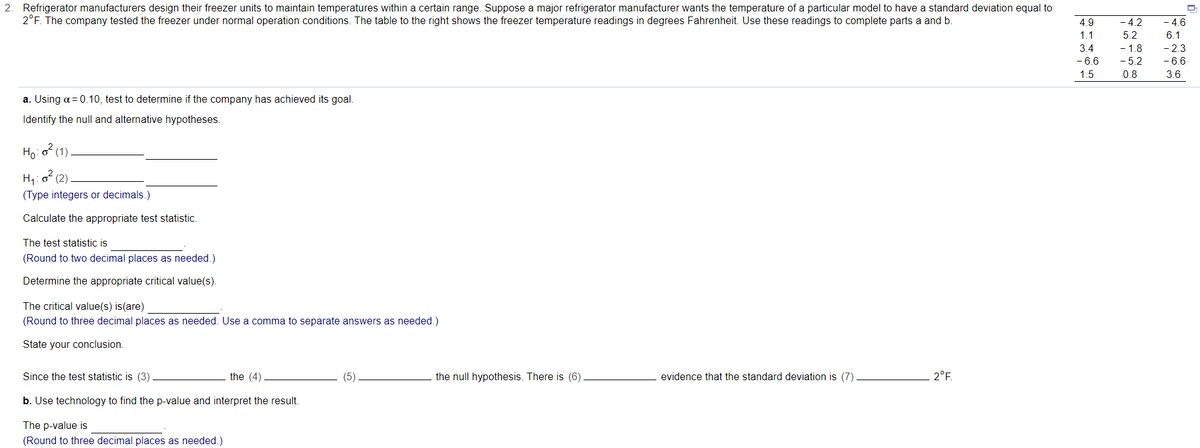2. Refrigerator manufacturers design their freezer units to maintain temperatures within a certain range. Suppose a major refrigerator manufacturer wants the temperature of a particular model to have a standard deviation equal to 2°F. The company tested the freezer under normal operation conditions. The table to the right shows the freezer temperature readings in degrees Fahrenheit. Use these readings to complete parts a and b. 4.6 6.1 -2.3 - 6.6 3.6 4.9 -4.2 1.1 5.2 3.4 -66 1.5 -1.8 -52 0.8 a. Using a=0.10, test to determine if the company has achieved its goal. Identify the null and alternative hypotheses. Ho o (1. H: o (2) (Type integers or decimals Calculate the appropriate test statistic. The test statistic is (Round to two decimal places as needed.) Determine the appropriate critical value(s). The critical value(s) is(are) (Round to three decimal places as needed. Use a comma to separate answers as needed.) State your conclusion. Since the test statistic is (3) the (4) (5) the null hypothesis. There is (6). evidence that the standard deviation is (7) 2°F. b. Use technology to find the p-value and interpret the result. The p-value is (Round to three decimal places as needed)
2. Refrigerator manufacturers design their freezer units to maintain temperatures within a certain range. Suppose a major refrigerator manufacturer wants the temperature of a particular model to have a standard deviation equal to 2°F. The company tested the freezer under normal operation conditions. The table to the right shows the freezer temperature readings in degrees Fahrenheit. Use these readings to complete parts a and b. 4.6 6.1 -2.3 - 6.6 3.6 4.9 -4.2 1.1 5.2 3.4 -66 1.5 -1.8 -52 0.8 a. Using a=0.10, test to determine if the company has achieved its goal. Identify the null and alternative hypotheses. Ho o (1. H: o (2) (Type integers or decimals Calculate the appropriate test statistic. The test statistic is (Round to two decimal places as needed.) Determine the appropriate critical value(s). The critical value(s) is(are) (Round to three decimal places as needed. Use a comma to separate answers as needed.) State your conclusion. Since the test statistic is (3) the (4) (5) the null hypothesis. There is (6). evidence that the standard deviation is (7) 2°F. b. Use technology to find the p-value and interpret the result. The p-value is (Round to three decimal places as needed)
Glencoe Algebra 1, Student Edition, 9780079039897, 0079039898, 2018
18th Edition
ISBN:9780079039897
Author:Carter
Publisher:Carter
Chapter10: Statistics
Section10.3: Measures Of Spread
Problem 26PFA
Related questions
Question

Transcribed Image Text:2. Refrigerator manufacturers design their freezer units to maintain temperatures within a certain range. Suppose a major refrigerator manufacturer wants the temperature of a particular model to have a standard deviation equal to
2°F. The company tested the freezer under normal operation conditions. The table to the right shows the freezer temperature readings in degrees Fahrenheit. Use these readings to complete parts a and b.
4.9
- 4.2
- 4.6
1.1
5.2
6.1
- 1.8
- 5.2
- 2.3
- 6.6
3.4
- 6.6
1.5
0.8
3.6
a. Using a = 0.10, test to determine if the company has achieved its goal.
Identify the null and alternative hypotheses.
Ho:o? (1)
H1:
(Type integers or decimals.)
(2)
Calculate the appropriate test statistic.
The test statistic is
(Round to two decimal places as needed.)
Determine the appropriate critical value(s).
The critical value(s) is(are)
(Round to three decimal places as needed. Use a comma to separate answers as needed.)
State your conclusion.
Since the test statistic is (3)
the (4)
(5)
the null hypothesis. There is (6)
evidence that the standard deviation is (7)
2°F.
b. Use technology to find the p-value and interpret the result.
The p-value is
(Round to three decimal places as needed.)

Transcribed Image Text:Since the p-value is (8)
α, ( 9)
the null hypothesis. There is (10)
evidence to conclude that the standard deviation is (11)
2°F.
(4) O lower critical value,
(5) O do not reject
O sufficient
(9) O do not reject
O reject
(1) O
(2) O
(3) O greater than
(6)
(7)
less than
(8)
less than
(10) O insufficient
O upper critical value,
O critical values,
O critical value,
O less than
O reject
O insufficient
O greater than
O sufficient
O not equal to
O equal to
O between
O greater than
O equal to
O greater than
(11)
less than
O not equal to
000
Expert Solution
This question has been solved!
Explore an expertly crafted, step-by-step solution for a thorough understanding of key concepts.
This is a popular solution!
Trending now
This is a popular solution!
Step by step
Solved in 4 steps

Recommended textbooks for you

Glencoe Algebra 1, Student Edition, 9780079039897…
Algebra
ISBN:
9780079039897
Author:
Carter
Publisher:
McGraw Hill

Glencoe Algebra 1, Student Edition, 9780079039897…
Algebra
ISBN:
9780079039897
Author:
Carter
Publisher:
McGraw Hill